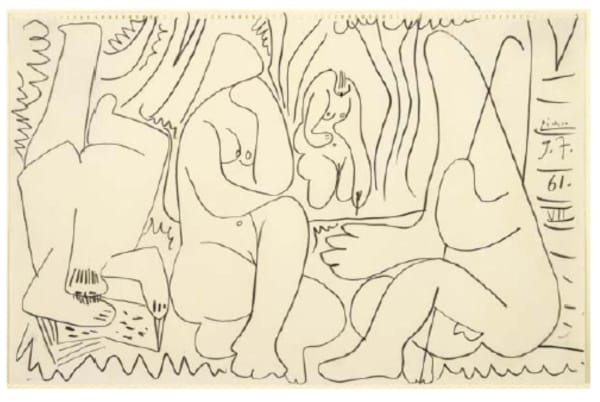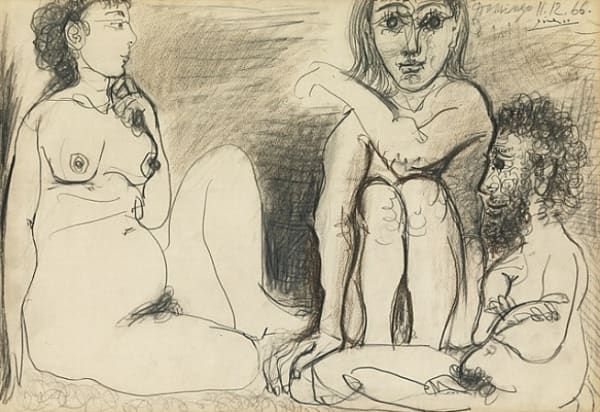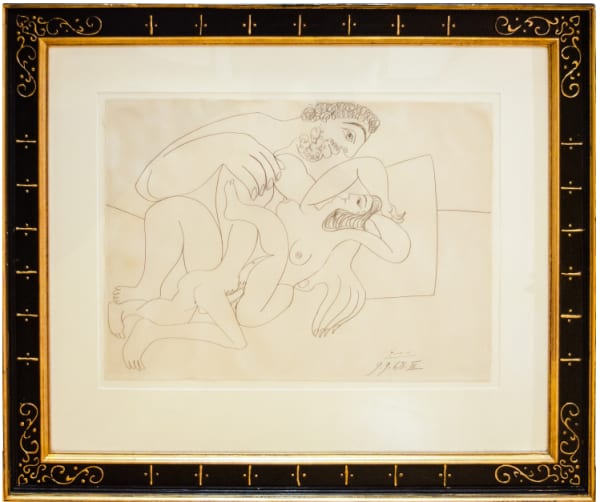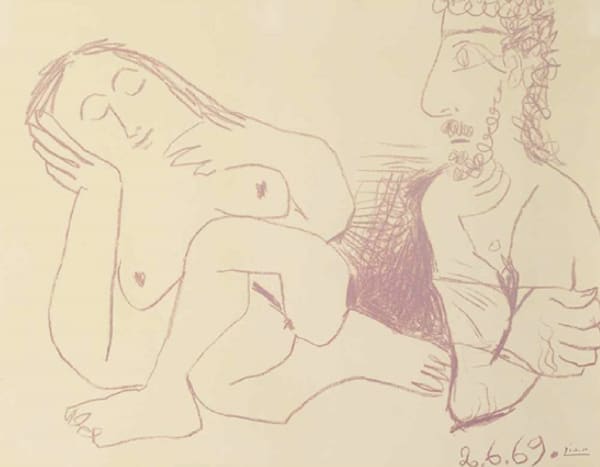
Pablo Picasso
Signed and dated
48.3 x 63.5 cm
This drawing, completed on March 6, 1967, exemplifies Pablo Picasso’s dynamic late-period style, a time of expressive liberation, mythic storytelling, and continued experimentation with form and media. Executed in coloured crayons on paper, Teenager, Eagle and Donkey brims with energy and symbolism. Its vibrant palette, rapid linework, and layered imagery combine to create a whimsical yet charged composition, drawing from classical iconography, contemporary emotion, and childlike spontaneity—all of which were hallmarks of Picasso’s late work.
At the center of the image is a donkey, its face drawn in crisp cobalt blue and marked with black lines that create an expressive, almost mask-like effect. To the donkey’s left is a youthful male figure, identifiable as a teenager by his slight frame, cropped hair, and wide, curious gaze. His face is dramatically shaded in red and blue, split vertically, recalling theatrical makeup or symbolic duality.
On the right sits a second, more muscular figure crowned with green foliage, echoing classical representations of Dionysus or Bacchus. His body, like the teenager’s, is outlined in loose red and blue crayon, emphasizing movement and psychological intensity. The figure grips the donkey’s neck with tender familiarity, suggesting a mythical or allegorical relationship.
To the left of the composition perches a large, imposing eagle, drawn with vigorous black strokes that contrast with the coloured lines elsewhere. Its presence is symbolic and foreboding—perhaps representing strength, wisdom, or imperial force. The three main subjects—boy, man, and eagle—exist in a dreamlike pastoral space suggested by yellow ground lines and softly undulating rainbow-coloured hills in the background.
The entire scene is infused with symbolic resonance. The donkey, historically associated with humility and endurance, stands between two contrasting male figures—youth and maturity, innocence and power. The eagle introduces a further mythic dimension, evoking Zeus, Roman emblems, or prophetic vision.
By 1967, Picasso was in his mid-80s but remained astonishingly prolific. The late 1960s marked a period of vigorous drawing, particularly with crayon, felt-tip pen, and ink. These works are characterised by their rapid execution, vivid colour, and narrative looseness. They draw on mythology, classical literature, and Picasso’s own life experiences, creating an aesthetic that is both deeply personal and universally archetypal.
This drawing belongs to a body of work in which Picasso explored themes of youth, virility, and myth. Figures often appear naked, animalistic, or in communion with nature—less as individuals and more as symbols within a larger theatre of human emotion and cosmic rhythm. Like many of Picasso’s late compositions, Teenager, Eagle and Donkey refuses rigid interpretation. Instead, it invites viewers into a world of allusion, where bodies, beasts, and landscapes intermingle in primal harmony.
Coloured crayon on paper allowed Picasso to work with speed and fluidity, often capturing an entire narrative or tableau in a single sitting. In this piece, the use of overlapping colours—especially red and blue for shading human forms—produces a vibrant psychological effect. The drawing retains the rawness and immediacy of a sketch, yet it is highly composed in balance and line quality. The layering of colour and movement gives the image a kind of visual improvisation, echoing both childlike drawing and the refined gestures of a seasoned master.
Teenager, Eagle and Donkey is a quintessential example of Picasso’s mythic imagination and late-style confidence. Through bold line, colour, and character, the artist weaves a scene that is simultaneously innocent and charged with symbolic meaning. It reveals Picasso not as an old man reminiscing, but as an eternal creator—playful, mythological, and endlessly inventive.
For more information, contact our galleries via the inquiry form below.
-
 Pablo PicassoThe Foot Bath | Le Bain de pieds, 1960
Pablo PicassoThe Foot Bath | Le Bain de pieds, 1960 -
 Pablo PicassoFemme tenant un journal, 1915
Pablo PicassoFemme tenant un journal, 1915 -
 Pablo PicassoTrois Personnages,, 1954
Pablo PicassoTrois Personnages,, 1954 -
 Pablo PicassoQuatre têtes d’élégantes (Four Elegant Heads), c. 1899
Pablo PicassoQuatre têtes d’élégantes (Four Elegant Heads), c. 1899 -
 Pablo PicassoLes déjeuners,, 1961
Pablo PicassoLes déjeuners,, 1961 -
 Pablo PicassoTête de faune, 1958
Pablo PicassoTête de faune, 1958 -
 Pablo PicassoTrois hommes et femme nus, 1967
Pablo PicassoTrois hommes et femme nus, 1967 -
 Pablo PicassoLes Dejeuners, 1961
Pablo PicassoLes Dejeuners, 1961 -
 Pablo PicassoTrois Personnages nus Assis, 1966
Pablo PicassoTrois Personnages nus Assis, 1966 -
 Pablo PicassoHomme et Femme, 1926
Pablo PicassoHomme et Femme, 1926 -
 Pablo PicassoL’Etreinte, 1968
Pablo PicassoL’Etreinte, 1968 -
 Pablo Picasso·Toros, 1961
Pablo Picasso·Toros, 1961 -
 Pablo Picasso·Étude pour la Suite Des Déjeuners III, 1959
Pablo Picasso·Étude pour la Suite Des Déjeuners III, 1959 -
 Pablo PicassoLe déjeuner, 1962
Pablo PicassoLe déjeuner, 1962 -
 Pablo PicassoLes déjeuners,, 1961
Pablo PicassoLes déjeuners,, 1961 -
 Pablo PicassoHomme Assis, 1971
Pablo PicassoHomme Assis, 1971 -
 Pablo PicassoBust of Naked Man and Woman, 1969
Pablo PicassoBust of Naked Man and Woman, 1969
Join our mailing list
* denotes required fields
We will process the personal data you have supplied in accordance with our privacy policy (available on request). You can unsubscribe or change your preferences at any time by clicking the link in our emails.
This website uses cookies
This site uses cookies to help make it more useful to you. Find out more about cookies.
















